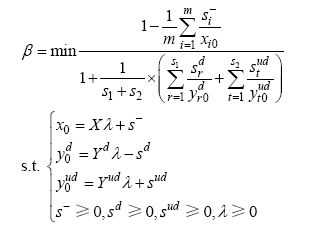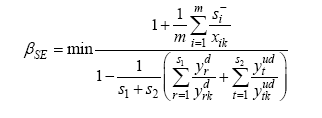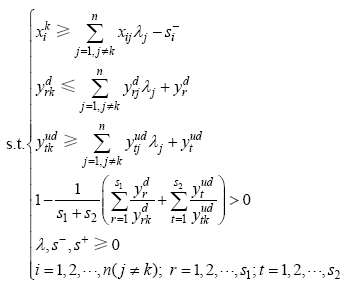

Journal of Resources and Ecology >
Spatiotemporal Differentiation and the Factors Influencing Eco-efficiency in China
Received date: 2020-09-01
Accepted date: 2020-11-25
Online published: 2021-05-30
Supported by
The National Natural Science Foundation of China(41771181)
The National Natural Science Foundation of China(41661116)
The Shandong Social Science Planning Fund Program(20CJJJ04)
Economic development, resource utilization, and environmental protection have always presented clear dilemmas for many countries at the national level. It is clear that the related concepts of eco-efficiency and the evaluation index can help in evaluating these associated issues. Thus, based on the use of undesirable output super Slacks-Based Measure models, this study evaluated the eco-efficiency of 30 Chinese provinces during the period between 2005 and 2016. This evaluation was conducted by analyzing the spatiotemporal dynamics and key factors influencing these changes using a panel regression model. The results of this analysis reveal that eco-efficiency gradually increased over the course of the study period, peaking at different levels among the regions. We used the conventional CV evolutionary method to show that inequalities in eco-efficiency gradually decreased at the national level. Indeed, our estimations of the factors affecting this variable suggest that industrial structure, degree of openness, urbanization, technical innovation, and environmental governance all exert significant positive influences, while energy consumption and traffic exert negative effects. The extent of the impacts of these factors on eco-efficiency varied between the different regions.
LI Qiuying , LIANG Longwu , WANG Zhenbo . Spatiotemporal Differentiation and the Factors Influencing Eco-efficiency in China[J]. Journal of Resources and Ecology, 2021 , 12(2) : 155 -164 . DOI: 10.5814/j.issn.1674-764x.2021.02.003



Table 1 Descriptive statistics for the input and output indicators between 2005 and 2016 |
| Category | Variable | Units | Mean | Std. dev | Min | Max |
|---|---|---|---|---|---|---|
| Inputs | Capital (I1) | 108 yuan | 12061.37 | 10861.52 | 323.68 | 54758.30 |
| Labor force (I2) | 104 persons | 497.01 | 343.72 | 40.92 | 1973.30 | |
| Land resource (I5) | km2 | 1458.72 | 1031.98 | 105.92 | 5266.60 | |
| Water super (I3) | 108 t | 201.26 | 150.30 | 22.33 | 1220.00 | |
| Energy resource (I4) | 104 t of SCEa | 12943.66 | 8140.66 | 822.00 | 38899.00 | |
| Undesirable Outputs | Total waste water (UO1) | 104 t | 169264.71 | 165867.70 | 3396.00 | 938261.00 |
| Industrial SO2 emission (UO2) | 104 t | 58.76 | 41.24 | 2.00 | 182.74 | |
| Industrial soot emission (UO3) | 104 t | 35.95 | 29.11 | 0.76 | 179.77 | |
| Industrial solid wastes emission (UO4) | 104 t | 8621.19 | 7972.33 | 127.00 | 45575.83 | |
| Desirable output | GDP (DO1) | 108 yuan | 16900.45 | 15341.25 | 543.32 | 80854.91 |
Note: a SCE means standard coal equivalents. |
Table 2 Influencing factor indicators |
| Factor | Indicator | Abbreviation | Unit |
|---|---|---|---|
| Economic development | Per capita GDP | ED | 104 yuan |
| Industrial structure | Secondary industry as a proportion of GDP | IS | % |
| Openness | FDI as a proportion of GDP | OP | % |
| Urbanization | Proportion of urban population | UR | % |
| Technical innovation | Expenditure for R&D as a proportion of GDP | TI | % |
| Governance capacity of the environment | Expenditure for environmental protection as a proportion of GDP | EG | % |
| CO2 emission intensity | Carbon dioxide emission intensity | EC | t (104 yuan)‒1 |
| Traffic conditions | Civil vehicle possession | TR | vehicle |
Fig. 1 Average eco-efficiency values for the whole country and the four Chinese regions during 2005‒2016 |
Fig. 2 Maps showing the spatial distribution patterns in Chinese provincial ecological efficiency in 2005, 2008, 2012 and 2016. |
Table 3 Annual average scores for eco-efficiency and provincial rankings between 2005 and 2016, 2005 and 2010, and 2011 and 2016 |
| Province | 2005‒2016 | 2005‒2010 | 2011‒2016 | Province | 2005‒2016 | 2005‒2010 | 2011‒2016 | |||||||||
|---|---|---|---|---|---|---|---|---|---|---|---|---|---|---|---|---|
| Rank | Score | Rank | Score | Rank | Score | Rank | Score | Rank | Score | Rank | Score | |||||
| Tianjin | 1 | 1.045 | 2 | 1.028 | 1 | 1.062 | Guangxi | 16 | 0.513 | 15 | 0.441 | 20 | 0.584 | |||
| Qinghai | 2 | 1.037 | 1 | 1.089 | 3 | 0.985 | Hubei | 17 | 0.502 | 19 | 0.407 | 17 | 0.597 | |||
| Hainan | 3 | 0.974 | 3 | 0.971 | 5 | 0.976 | Liaoning | 18 | 0.501 | 24 | 0.387 | 15 | 0.614 | |||
| Shanghai | 4 | 0.921 | 5 | 0.864 | 4 | 0.978 | Jiangxi | 19 | 0.500 | 17 | 0.422 | 21 | 0.579 | |||
| Beijing | 5 | 0.918 | 4 | 0.893 | 6 | 0.943 | Sichuan | 20 | 0.495 | 20 | 0.406 | 19 | 0.584 | |||
| Guangdong | 6 | 0.839 | 6 | 0.686 | 2 | 0.991 | Ningxia | 21 | 0.486 | 26 | 0.377 | 18 | 0.595 | |||
| Jiangsu | 7 | 0.745 | 7 | 0.590 | 7 | 0.901 | Jilin | 22 | 0.486 | 22 | 0.393 | 22 | 0.578 | |||
| Shandong | 8 | 0.716 | 8 | 0.551 | 8 | 0.881 | Chongqing | 23 | 0.477 | 25 | 0.387 | 23 | 0.567 | |||
| Zhejiang | 9 | 0.686 | 10 | 0.543 | 9 | 0.830 | Anhui | 24 | 0.473 | 21 | 0.393 | 24 | 0.553 | |||
| Fujian | 10 | 0.645 | 9 | 0.546 | 10 | 0.743 | Shanxi | 25 | 0.462 | 16 | 0.441 | 27 | 0.483 | |||
| Hunan | 11 | 0.581 | 14 | 0.444 | 11 | 0.718 | Yunnan | 26 | 0.460 | 23 | 0.389 | 25 | 0.531 | |||
| Hebei | 12 | 0.575 | 11 | 0.478 | 12 | 0.672 | Guizhou | 27 | 0.426 | 29 | 0.352 | 26 | 0.500 | |||
| Henan | 13 | 0.544 | 12 | 0.452 | 13 | 0.635 | Heilongjiang | 28 | 0.421 | 27 | 0.375 | 28 | 0.466 | |||
| Shaanxi | 14 | 0.530 | 13 | 0.448 | 16 | 0.611 | Gansu | 29 | 0.385 | 28 | 0.361 | 29 | 0.409 | |||
| Inner Mongolia | 15 | 0.515 | 18 | 0.412 | 14 | 0.618 | Xinjiang | 30 | 0.339 | 30 | 0.313 | 30 | 0.364 | |||
Table 4 Provincial eco-efficiency value distribution across China |
| Group | First | Second | Third | Fourth | Fifth | Sixth |
|---|---|---|---|---|---|---|
| Scores | > 1.00 | 0.80‒1.00 | 0.60‒0.80 | 0.50‒0.60 | 0.40‒0.50 | < 0.4 |
| Number of provinces | 2 | 4 | 4 | 9 | 9 | 2 |
| Proportion (%) | 6.67 | 13.33 | 13.33 | 30.00 | 30.00 | 6.67 |
Fig. 3 Eco-efficiency volatility ratio values for all of China and the four Chinese regions duing 2005‒2016 |
Fig. 4 Eco-efficiency volatility ratio values for the 30 Chinese provinces between 2005 and 2016 Notes: Hong Kong, Macao, Taiwan and Tibet were excluded due to limited data availability. |
Table 5 Panel data regression results encompassing time fixed effects |
| Factor | China | East | Central | West | Northeast |
|---|---|---|---|---|---|
| ED | 0.452 (8.30) | ‒0.058 (‒0.43) | 0.131*** (1.04) | 0.471** (3.95) | ‒0.465 (‒3.77) |
| IS | 0.132*** (‒1.50) | ‒1.009 (‒3.19) | 0.949** (4.50) | 0.821*** (2.73) | ‒0.590** (‒2.67) |
| OP | 0.130*** (‒0.43) | 0.030*** (0.88) | ‒0.096 (‒2.67) | 0.190 (5.71) | ‒0.104*** (‒3.56) |
| UR | 0.545** (‒4.33) | 1.400** (4.01) | ‒0.309** (‒0.99) | ‒1.035*** (‒3.59) | 0.881 (‒1.66) |
| TI | 0.041** (‒0.38) | 0.014* (‒0.38) | 0.027* (‒1.77) | 0.105** (‒3.49) | ‒0.036 (‒1.61) |
| EG | 0.056** (2.59) | 0.029 (0.52) | 0.014*** (‒0.79) | 0.077** (‒1.53) | 0.074*** (‒1.31) |
| EC | ‒0.048*** (‒2.89) | ‒0.237*** (‒2.21) | ‒0.184*** (‒5.20) | ‒0.020 (‒1.07) | ‒0.044 (‒0.41) |
| TR | ‒0.062* (‒3.76) | ‒0.085** (2.27) | ‒0.030** (‒1.00) | ‒0.080 (‒3.11) | 0.574 (6.28) |
| constant | ‒1.520*** (-2.77) | ‒6.737 (0.668) | 1.488 (1.69) | 0.843*** (0.88) | 4.222*** (1.93) |
| R2 | 0.526 | 0.583 | 0.833 | 0.658 | 0.871 |
| F-statistic | 29.660 | 16.474 | 20.315 | 19.146 | 17.921 |
Note: Brackets enclose t-statistics, while ***, **, and * denote significance at 1%, 5%, and 10% levels, respectively. |
| 1 |
|
| 2 |
|
| 3 |
|
| 4 |
|
| 5 |
|
| 6 |
|
| 7 |
|
| 8 |
|
| 9 |
|
| 10 |
|
| 11 |
|
| 12 |
|
| 13 |
|
| 14 |
|
| 15 |
|
| 16 |
|
| 17 |
|
| 18 |
|
| 19 |
|
| 20 |
|
| 21 |
|
| 22 |
|
| 23 |
|
| 24 |
|
| 25 |
|
| 26 |
|
| 27 |
|
| 28 |
|
| 29 |
|
| 30 |
|
| 31 |
|
/
| 〈 |
|
〉 |